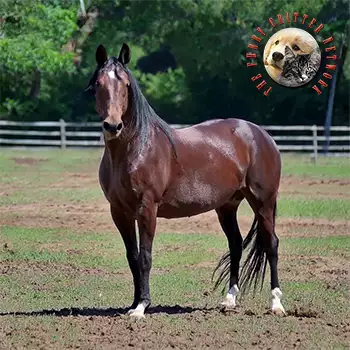History
The origins of the Standardbred trace back to Messenger, an English Thoroughbred foaled in 1780, and later exported to the United States. Messenger was the great-grandsire of Hambletonian 10, to whom every Standardbred can trace its heritage. Thus, Standardbreds are a relatively new breed, dating back just over 200 years.
The name "Standardbred" originated because the early trotters (Standardbreds would not come into favor until much later) were required to reach a certain standard for the mile distance in order to be registered as part of the new breed. The mile is still the standard distance covered in nearly every harness race.
The first Standardbred races were contested along roads, with men challenging their friends to see who had the swifter steed. Often the streets of major cities were cleared and races conducted. That's why so many American cities have a Race Street.
Over the years, sportsmen came to recite the names of certain champions with awe: Flora Temple, the "Bob-Tailed Nag" of Stephen Foster's Camptown Races; Goldsmith Maid, who won 350 heats in her storied career; world champions Maud S. and Nancy Hanks.
They were all trotters but Standardbreds soon began to gain acceptance with the sport's first two-minute mile, recorded in 1897 by the Standardbred Star Pointer.
The horse who popularized pacing was Dan Patch, one of the fastest (1:55 for the mile) and most popular Standardbreds ever.
Harness racing continued to flourish until World War I, after which the sport suffered two lean decades. But world records by Standardbred Billy Direct and trotter Greyhound in 1938 signaled a rebirth, and the sport began to move forward in 1940 when a group of businessmen took the heretofore rural sport and set it in the bright lights of New York City as a pari-mutuel activity. It was years before the new track, Roosevelt Raceway, on Long Island made money, but the night time "sulkies" soon caught on in many metropolitan areas, and today harness racing is firmly established as one of the biggest of big-league sports.
The past few years have seen major improvements in racetrack construction and maintenance; in sulky and harness design; and in the breed itself. The legendary Niatross heralded a new era with a 1:49-1/5 time-trial, the first harness horse to break 1:50.
Behavior
Standardbreds are considered people-oriented, easy-to-train horses.
Standardbreds are making the successful transition to lives and careers that are far removed from the racetrack. In addition to being the world?s fastest horse in harness, the Standardbred excels in a variety of equine disciplines. Representatives of this breed are able to face every task put before them with gentleness, patience, and a heart that knows no limit.
The Standardbred's personality is much different than you might expect from a racing athlete. When competing, he may appear somewhat fierce in his pursuit of victory, but the Standardbred is good natured, friendly, a quick learner and is known for having a calm disposition.
Function
Standardbreds are known for their skill in harness racing, being the fastest trotting horses in the world. Because of their speed, Standardbreds are often used to upgrade other breeds of harness racers around the world, such as the Orlov Trotter and French Trotter.
Standardbreds are also used in horse shows and for pleasure riding. They are also popular as light buggy horses for the Amish people, who eschew motorized vehicles. Many retired Standardbreds find a second career off the track with the help of organizations such as the Standardbred Pleasure Horse Organization.
The breed is quite good at jumping, making them suitable for the sport horse disciplines of hunt seat, show jumping, show hunter, and eventing. The breed is also seen in dressage, and their excellent temperaments make them good trail riding and ranch horses.
In addition, because of the genetics of the breed, they can also be encouraged and trained to perform smooth ambling gaits, notably the rack and the stepping pace. The number of gaited Standardbreds is steadily growing in the United States, with some stud farms dedicated to breeding individuals with this characteristic. Standardbreds are also gaining popularity in Australia as endurance horses, from the 20 km social rides and 40 km training rides, up to the 80 km endurance rides. They are known for their strong and dense bones, suitable conformation and ability to maintain high trotting speeds for extended periods of time comfortably. The kind and manageable temperament of the breed also contributes to its popularity. These features are especially attractive to riders who do not wish to be competitive against the purpose-bred Arabian horses, which are often more difficult and competitive to ride.
Health
No breed specific issues.






